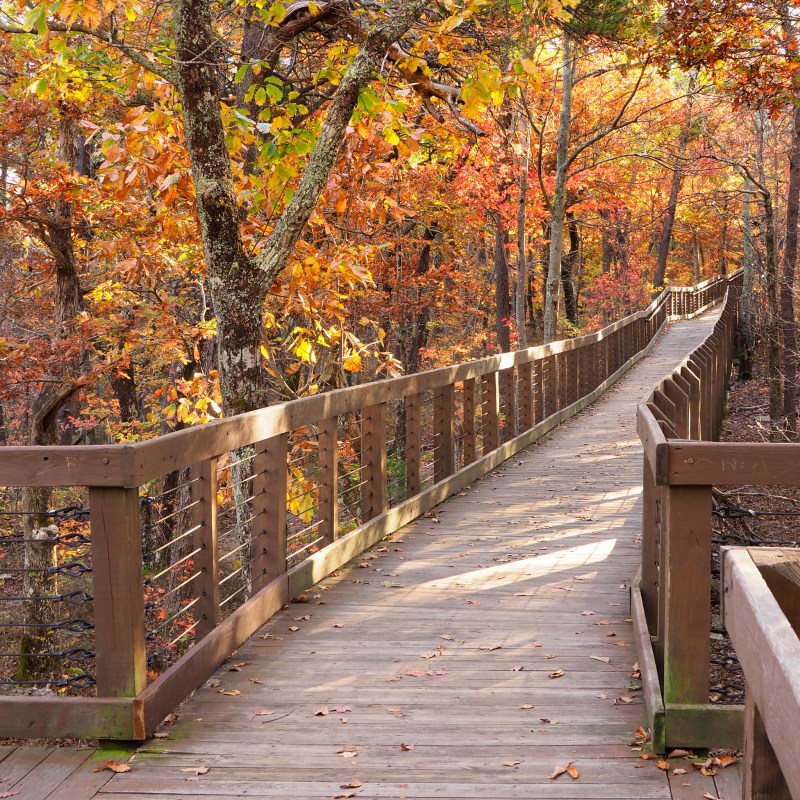
Summertime heat suddenly vanishes, replaced by a cool northerly breeze. The air is fresh and crisp, a wonderful respite from the oppressive humidity. The mountain landscapes begin to change; their almost monotonous greens change to breathtaking yellows, fiery reds, and dazzling oranges.
Videos by TravelAwaits
Now don’t get me wrong. Alabama’s natural beauty is spectacular any time of year, but in the fall, it really puts on a show you shouldn’t miss.
Since Alabama is in the deep South, the leaves tend to change a little later than most other states, usually starting in earnest in mid-October in the northeast, then quickly spreading southward across the state.
Pack up the car, lace up your walking shoes, and check out the color show at these destinations.
1. Oak Mountain State Park
Stroll, hike, or drive. No matter how you visit Oak Mountain State Park in Pelham, you are guaranteed a front-row seat for a brilliant fall palette. Drive along the seven-mile-long John Findley Drive lined with the fiery colors of chestnut, white, and cherry bark red oak trees.
Stroll around the banks of Double Oak and Tranquility Lakes, where the fall colors are reflected in their tranquil waters.
For the more adventurous, take to one of the park’s 25 miles of hiking trails with varying degrees of difficulty ranging from easy walks in the woods to the challenging hike up to the King’s Chair where you will have a bird’s-eye view.
Make your visit extra special by booking a night or two in one of the park cabins. Each cabin has two bedrooms, a bathroom, a kitchenette with utensils and cookware, and a satellite TV. And you’re right on the lake, giving you hours of fall beauty.

2. Cheaha State Park
The southern Appalachians put on a spectacular show in the fall, and the best place to view the spectacle is atop the state’s tallest mountain, Cheaha, in the town of Delta. There are several vantage points where you can take in the colors at the mountain’s namesake park.
For hikers, there is the short (less than half-mile out-and-back) and moderately difficult Pulpit Rock Trail that leads you to a rock outcropping that hangs precariously in the air, offering a 180-degree view of the rainbow of colors below. If you’re up to a real challenge, take a walk down the difficult Lower Spring Trail to the Boulder Garden for yet another breathtaking view.
For those who are less adventurous, follow the Doug Ghee Boardwalk along the mountain’s ridge to a beautiful vista from Bald Rock. The boardwalk is ADA accessible.

3. The Skyway Motorway
Immerse yourself in fall colors with a drive along the Skyway Motorway (also known as Alabama Highway 281) in Delta. The highway, which was originally built to be an answer to the Blue Ridge Parkway in Tennessee and Virginia, winds along the ridges of the Talladega Mountains for nearly 30 miles. The best section is the 12 miles from Cheaha State Park north to U.S. Highway 431. You will be driving through a seemingly endless pathway of fall colors, with several overlooks along the way for spectacular views of the surrounding mountains adorned in autumn’s finest. One of the best overlooks is located only five miles northeast of Cheaha.
4. Little River Canyon
The deepest canyon east of the Mississippi, the Little River Canyon National Preserve gives you ample opportunity to view nature at its finest with incredible fall foliage views along the preserve’s Canyon Rim Drive. The roadway (which is actually Alabama State Road 176) hugs the canyon’s western rim, with numerous overlooks into the deep gorge framed with autumn colors. The drive begins (or ends, depending on traveling direction) at the Little River Canyon Center, where you can get a good view of the spectacular Little River Falls and its namesake river that formed the canyon.
Heading south, you will make several stops with views at the Lynn, Hawks Glide, Canyon View, and Wolf Creek Overlooks, to name only a few.
While you’re at the preserve, take the time to visit the Little River Canyon Center. It is a fascinating look into the wildlife and geology that makes the canyon so special.

5. DeSoto State Park
One of my personal favorites for leaf-peeping is DeSoto State Park in Fort Payne. The park has 30 miles of hiking trails that are mostly on the easy walking side (with the exception of the DeSoto Scout Trail) through the forest of poplars, maples, and hickories. But as the park’s staff is more than happy to remind you, there is more to autumn at DeSoto than just the change in leaf color. The trails are also lined with an amazing array of fall wildflowers and berries, including bright red meadow berry, winged sumac, and the thorny devil’s walking stick, to name only a few.
Before you start your day or when you take a mid-afternoon break, sit down for a delicious breakfast or lunch at DeSoto’s rustic Mountain Inn Restaurant. The sandstone building was constructed by the Civilian Conservation Corps in the 1930s and was DeSoto’s original lodge.

6. Monte Sano State Park
Another favorite location for viewing the colors of fall in Alabama is Monte Sano State Park in Huntsville. Once again, you will have easy access either by car or on foot. For hikers, the best trails in the park for viewing the color-drenched white and southern red oak trees are the North and South Plateau Loop trails.
The South Plateau Loop is a moderately difficult three-mile loop around the mountain’s rim, leading to O’Shaughnessy Point, which offers a stunning panoramic view from the rock outcropping into the valley below known as Big Cove. The North Plateau Loop is an easy two-mile loop that’s good for hikers of all ages. It takes you to two spectacular overlooks as you walk along the color-drenched pathway.
You can also drive to the two overlooks found on the North Plateau Loop — one at the park’s lodge, the other on the park’s northern boundary — making them the perfect stop if you have small children and for people who need an accessible experience.
Pro Tip: What better way to celebrate fall than with a good old Oktoberfest? The two-week event began as a wedding celebration for Bavaria’s crown prince in 1810 and today is celebrated with plenty of beer and German food throughout the world. The best place to experience Oktoberfest while in Huntsville is at Hildegard’s German Cuisine.
7. Bankhead National Forest
The Bankhead National Forest is a sprawling 180,000-acre forest and wilderness area in northwest Alabama where, in the fall, yellow poplar, yellow birch, red maple, and white oaks flood the senses with dazzling color.
The forest has over 90 miles of recreational trails for you to hike and bike as well as countless forest roads to drive down and lose yourself in the display. To top it off, the forest is also known as the Land of a Thousand Waterfalls. Tucked away within the colorful forest are literally hundreds of spectacular waterfalls, all enhanced when they are framed with nature’s finest colors.

8. The Covered Bridges Of Blount County
The final stop on our search for fall colors in Alabama takes us to the three covered bridges of Blount County — Swann, Horton Mill, and Easley. All three are located within less than 20 miles of each other, providing a nostalgic backdrop to the already colorful landscape that conjures up images of fall in New England, steaming cups of hot apple cider, and horse-drawn carriage rides in the crisp fall air. However, here, you will be driving your car.
Swann is just off Alabama Highway 231 in Cleveland and offers a stunning view down Locust Fork. Horton Mill in Oneonta is one of the highest covered bridges in the country. And Easley is a 1930s-era bridge also found in Oneonta.
Pro Tips
The peak of the season is all determined by Mother Nature. The state provides a Fall Color Predictor Map, which helps you fine-tune your trip so you can get the maximum views.
For more fall vantage points in Alabama, visit the Alabama Department of Tourism’s Fall Color Trail website.
Be courteous to other drivers as you wonder at nature’s beauty. Safely pull off to the side of the road to let others pass before continuing your journey.
